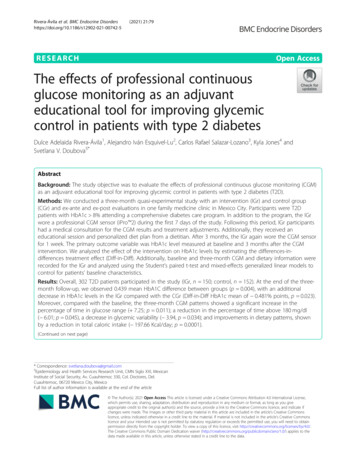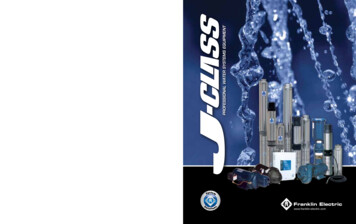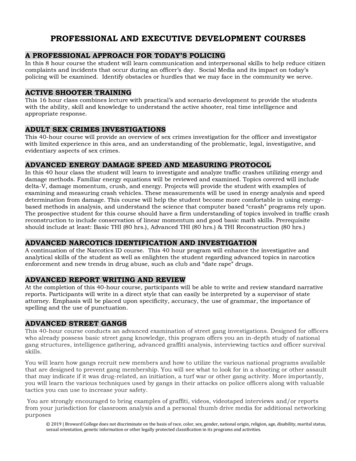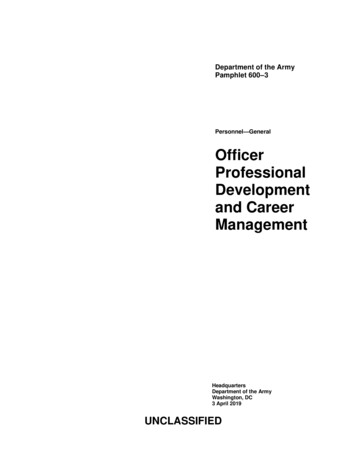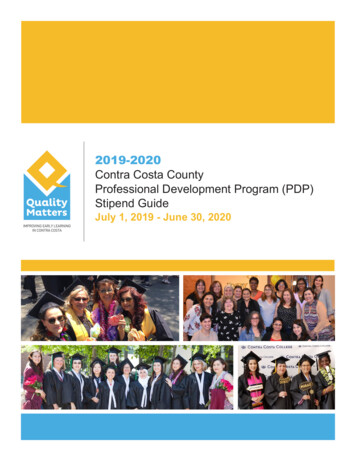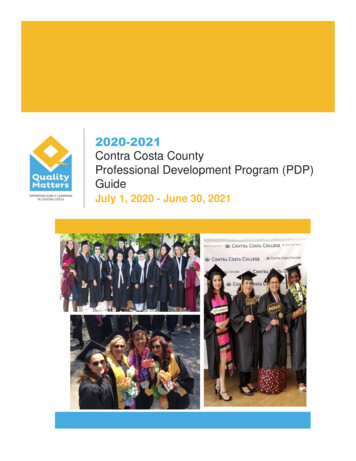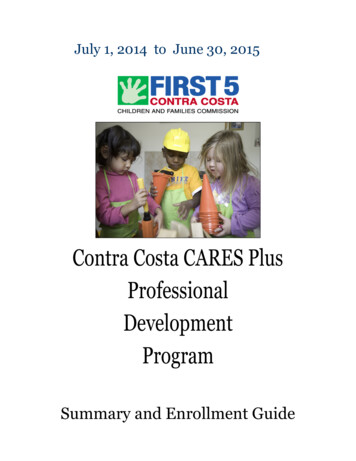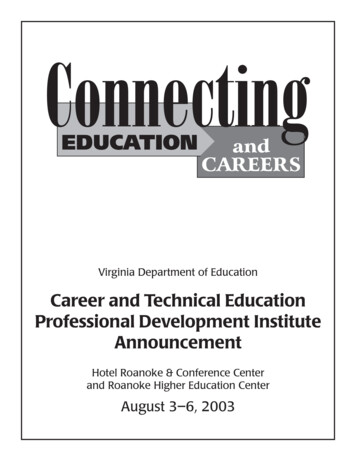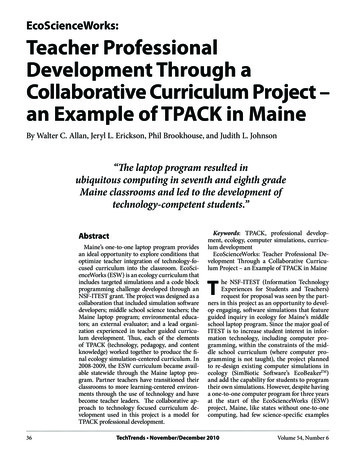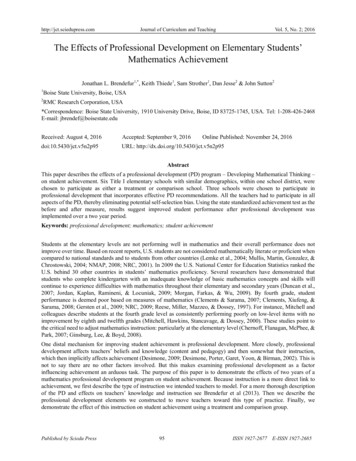
Transcription
http://jct.sciedupress.comJournal of Curriculum and TeachingVol. 5, No. 2; 2016The Effects of Professional Development on Elementary Students’Mathematics AchievementJonathan L. Brendefur1,*, Keith Thiede1, Sam Strother1, Dan Jesse2 & John Sutton21Boise State University, Boise, USA2RMC Research Corporation, USA*Correspondence: Boise State University, 1910 University Drive, Boise, ID 83725-1745, USA. Tel: 1-208-426-2468E-mail: jbrendef@boisestate.eduReceived: August 4, 2016Accepted: September 9, 2016Online Published: November 24, 2016doi:10.5430/jct.v5n2p95URL: http://dx.doi.org/10.5430/jct.v5n2p95AbstractThis paper describes the effects of a professional development (PD) program – Developing Mathematical Thinking –on student achievement. Six Title I elementary schools with similar demographics, within one school district, werechosen to participate as either a treatment or comparison school. Three schools were chosen to participate inprofessional development that incorporates effective PD recommendations. All the teachers had to participate in allaspects of the PD, thereby eliminating potential self-selection bias. Using the state standardized achievement test as thebefore and after measure, results suggest improved student performance after professional development wasimplemented over a two year period.Keywords: professional development; mathematics; student achievementStudents at the elementary levels are not performing well in mathematics and their overall performance does notimprove over time. Based on recent reports, U.S. students are not considered mathematically literate or proficient whencompared to national standards and to students from other countries (Lemke et al., 2004; Mullis, Martin, Gonzalez, &Chrostowski, 2004; NMAP, 2008; NRC, 2001). In 2009 the U.S. National Center for Education Statistics ranked theU.S. behind 30 other countries in students’ mathematics proficiency. Several researchers have demonstrated thatstudents who complete kindergarten with an inadequate knowledge of basic mathematics concepts and skills willcontinue to experience difficulties with mathematics throughout their elementary and secondary years (Duncan et al.,2007; Jordan, Kaplan, Ramineni, & Locuniak, 2009; Morgan, Farkas, & Wu, 2009). By fourth grade, studentperformance is deemed poor based on measures of mathematics (Clements & Sarama, 2007; Clements, Xiufeng, &Sarama, 2008; Gersten et al., 2009; NRC, 2009; Reese, Miller, Mazzeo, & Dossey, 1997). For instance, Mitchell andcolleagues describe students at the fourth grade level as consistently performing poorly on low-level items with noimprovement by eighth and twelfth grades (Mitchell, Hawkins, Stancavage, & Dossey, 2000). These studies point tothe critical need to adjust mathematics instruction: particularly at the elementary level (Chernoff, Flanagan, McPhee, &Park, 2007; Ginsburg, Lee, & Boyd, 2008).One distal mechanism for improving student achievement is professional development. More closely, professionaldevelopment affects teachers’ beliefs and knowledge (content and pedagogy) and then somewhat their instruction,which then implicitly affects achievement (Desimone, 2009; Desimone, Porter, Garet, Yoon, & Birman, 2002). This isnot to say there are no other factors involved. But this makes examining professional development as a factorinfluencing achievement an arduous task. The purpose of this paper is to demonstrate the effects of two years of amathematics professional development program on student achievement. Because instruction is a more direct link toachievement, we first describe the type of instruction we intended teachers to model. For a more thorough descriptionof the PD and effects on teachers’ knowledge and instruction see Brendefur et al (2013). Then we describe theprofessional development elements we constructed to move teachers toward this type of practice. Finally, wedemonstrate the effect of this instruction on student achievement using a treatment and comparison group.Published by Sciedu Press95ISSN 1927-2677E-ISSN 1927-2685
http://jct.sciedupress.comJournal of Curriculum and TeachingVol. 5, No. 2; 20161. Teaching to Promote Mathematical UnderstandingThere have been studies that have shown when teachers teach for understanding, achievement improves (Haycock,2001; Knapp, 1995; Newmann & Associates, 1996). Thus, before building a model for conducting professionaldevelopment in mathematics, we examined instructional structures that we wanted to observe in teachers’ classroompractices. From these structures we then proceeded to build a professional development model to encourage teachers topromote these instructional structures (Brendefur et al, 2013).Our concept of teaching for understanding is grounded in both a structural and functional perspective (Hiebert et al.,1996). From a structural position on understanding, the aim is for teachers to create conditions within students’classroom experiences for them to cognitively organize new information in ways that allow them to order and build awell-connected network of understanding. From a functional perspective, we focus on providing the types of tasks andactivities that place students in situations where, through articulation, they are able to reflect on how they solveproblems and construct relationships.In other words, in order for students to develop understanding, teachers must attend to both the structural andfunctional aspects of teaching the content within their classrooms. As Carpenter and Lehrer (1999) argue, “For learningwith understanding to occur, instruction needs to provide students the opportunity to develop productive relationships,extend and apply their knowledge, reflect about their experiences, articulate what they know, and make knowledgetheir own” (p. 32). These components became a foundation for our theoretical framework for instruction – DevelopingMathematical Thinking (DMT).1.1 Instructional Theory -- DMTThis section frames an approach to teaching mathematics for understanding. We describe this type of instruction asDeveloping Mathematical Thinking or DMT. This instructional model for teaching builds on Carpenter and Lehrer’s(1999) elements listed above and in addition incorporates notions of “guided reinvention” and “mathematizing”(Freudenthal, 1973, 1991; Treffers, 1987). As Gravemeijer and van Galen (2003) describe, guided reinvention is aprocess of first allowing students to develop informal strategies and ways to model these approaches for solvingproblems, and then, by critically examining both these strategies and models, encouraging students to develop moresophisticated, formal, conventional and abstract strategies and algorithms. By comparing solution strategies andexamining the relationship between iconic and symbolic models (Bruner, 1964), students learn which manipulationsmake sense for given contexts and are encouraged to develop more general procedures. Eventually, the contexts fadeinto the background and the “manipulations themselves acquire meaning of their own” (Gravemeijer & van Galen,2003, p. 116).Students are encouraged to make connections between existing knowledge (informal ideas) and new knowledge (moreformal mathematical ideas) required by Hiebert & Carpenter’s (1992) concept of structural understanding throughsolving novel problems. By critically examining their own and others’ strategies and models, students are encouragedto build functional understanding, which exemplifies the importance of social interactions in classrooms. “By thinkingand talking about similarities and differences between arithmetic procedures, students can construct relationshipsbetween them. the instructional goal is not necessarily to inform one procedure by the other, but rather, to helpstudents build a coherent mental network in which all pieces are joined to others with multiple links” (Hiebert &Carpenter, 1992, p. 68).Closely related to guided reinvention, the DMT instructional method incorporates Treffer’s (1987) notions ofhorizontal and vertical mathematization. Horizontal mathematization occurs when students represent a contextualizedproblem mathematically in order to find a solution strategy. Vertical mathematization involves taking themathematical matter to a higher level, and occurs when students make their representations and strategies objects ofmathematical examination. Mathematizing covers such activities as generalizing, justifying, formalizing, andcurtailing – including, but not limited to, developing an abstract algorithm (Gravemeijer & van Galen, 2003). Byfocusing on both types of mathematizing in their classrooms, teachers must maintain a focus on the inherent structureof the mathematical ideas that are emerging. In addition, they must address students’ misconceptions as they arise sothese misconceptions do not hinder the mathematizing progression. One outcome of mathematizing is that teachersconnect students’ informal ideas, many of which may be developed outside of school, with more formal mathematicalideas. “One would predict that if children possessed internal networks constructed both in and out of school, and if theyrecognized the connections between them, their understanding and performance in both settings would improve”(Hiebert & Carpenter, 1992, p. 79).Such a process starts with carefully chosen tasks – typically contextualized (Doerr, 2006; Larsen & Bartlo, 2009;Published by Sciedu Press96ISSN 1927-2677E-ISSN 1927-2685
http://jct.sciedupress.comJournal of Curriculum and TeachingVol. 5, No. 2; 2016Simon & Tzur, 2004). To solve these problems, students must model the situation to some degree. Rather thanbeginning with the standard algorithms and attempts to concretize them, teaching begins with students’ commonsensesolutions to contextual problems that are real for them. By reflecting on the solution procedures they have used,students develop and are introduced to more sophisticated models and procedures that they can also use in othersituations (Gravemeijer & van Galen, 2003, p. 114). In other words, teaching typically starts with considering students’ideas about solving real world problems and continues by keeping students’ ideas as the foundation for later years.Mathematical knowledge originates from students’ attempts to model contextual situations. These models then becomethe basis for solving related problems as well as a means of support for more formal mathematical reasoning(Gravemeijer & van Galen, 2003). As Cobb (2000) described, this use of modeling “ implies a shift in classroommathematical practices such that ways of symbolizing developed to initially express informal mathematical activitytake on a life of their own and are used subsequently to support more formal mathematical activity in a range ofsituations” (p. 319). In this way, modeling is a fundamental process in learning mathematics. However, this view ofmodels and modeling contrasts with current practices in mathematics instruction in which models are used to“concretize expert knowledge” (Gravemeijer & van Galen, 2003, p. 118) and contextual problems are presented onlyafter students have mastered traditional ways of solving problems. In this way, guided reinvention and mathematizingvia the use of mathematical modeling, turns the focus toward students’ ways of using models rather than on teacher orcurriculum created ways of using models.Through enacting aspects of ‘guided reinvention’ and ‘mathematizing’ teachers develop a classroom practice that isbased on the tenets of teaching for understanding. We believe their practice hinges on five key elements of classroompractice: the centrality of students’ ideas, encouraging multiple solution strategies and models, pressing studentsconceptually, addressing misconceptions and maintaining a focus on the structure of the mathematics (Brendefur,2008). By focusing their teaching practices on these five key elements (see Figure 1), elementary teachers shift theirattention toward students’ informal strategies for solving problems and the mathematical connections betweenmultiple mathematical models and formal solution strategies. By encouraging students to use informal knowledge andexperiences, student misconceptions are bound to arise. By acknowledging and addressing them, teachers encouragestudents to make sense of and correct their flawed ways of thinking, rather than glossing over them or ignoring themcompletely. The five key elements grow out of the concepts that mathematics exists of underlying inherent relatedconstructs and that students learn mathematics by creating web-like or hierarchical structures for these constructs.Figure 1. Components of Developing Mathematics ThinkingPublished by Sciedu Press97ISSN 1927-2677E-ISSN 1927-2685
http://jct.sciedupress.comJournal of Curriculum and TeachingVol. 5, No. 2; 20162. Professional Development to Promote DMT InstructionIn order for teachers to begin building these highly technical skills, the professional development must build teachers’knowledge of (a) the different situations to put students in to progressively formalize their thinking, (b) different waysstudents will respond to these mathematical situations, (c) how to build their initial, usually informal, ways ofmodeling the problem, (d) how to press their understanding, and (e) how to find or create additional situations to enablecontinual deeper understanding.Building on the literature reviews on instructional practices to promote mathematical understanding, we constructed aprofessional development framework to develop teachers’ mathematical thinking and pedagogy. To begin, we usedSimon’s (1995) conceptual model for learning and teaching referred to as hypothetical learning trajectories (HLT)(Baroody, Cibulskis, Lai, & Li, 2004; Clements & Sarama, 2004; Hiebert et al., 1997; Simon, 1995). Generally, anHLT describes the mathematical path teachers envision their students taking as they explore specific mathematicaldomains. HLT’s include theories of children’s initial ideas, a sequence of instructional tasks, and descriptions ofchildren’s progressions of learning and thinking.We prepared teachers to explore the terrain of mathematics in new ways. We encouraged them to examine“connections among concepts, their representations and the various contexts in which they may be embedded”(Schifter, 1996, p. 3). As part of this process, it was crucial that teachers began to question their own mathematicalknowledge (typically procedural) and the knowledge (based on real experiences) that their students bring to theclassroom. We did this by encouraging teachers in both explicit and embedded professional development to enact thefive elements of classroom practice described above and by helping them develop their own learning trajectories(Gravemeijer & van Galen, 2003; Simon, 1995) for various mathematical topics.More specifically, according to Simon (2005), HLT’s are made up of three components: the learning that defines thedirection, the learning activities, and the hypothetical learning process – a prediction of how the students’ thinking andunderstanding will evolve in the context of the learning activities. Baroody, et al (2004) emphasize that HLT’s shouldfocus on the “big ideas” and should incorporate both linear, or “ladder-like” trajectories, as well as multiple path or“branching tree” trajectories (p. 254). Hiebert, et al (1997) describe hypothetical learning trajectories as “ theteacher’s vision of the mathematical path that the students might take, and its hypothetical nature comes from the factthat it is based on the teacher’s guess about how learning might proceed along the path. The trajectory guides theteacher’s task selection, but feedback from students and the teacher’s assessments of the residues that are being formedlead to revisions in the trajectory. Tasks are selected purposefully, but the sequence can be revised” (p. 34).As an example, we posed addition problems through join and separate versus part-whole and compare problem types.Teachers first had to model or learn how to model the solution paths by using enactive, iconic and symbolicrepresentations. Next, teachers examined student work across grade levels to build trajectories of how students solvethese situations. Finally, teachers had to articulate different hypothesized instructional decisions based on whatstudents were doing. This element was very intense and difficult for teachers. Most of them wanted to just tell thestudents one, usually symbolic, way of solving the problem. Instead, we discussed different tasks to pose to studentsbased on how they solved the problem, different ways to notate their thinking, ways to help them formalize theirthinking and modeling, and how to extend or simplify the situation to meet the demands of all students.As Gravemeijer (2004) points out, HLT’s are tailored to a specific classroom and teacher at a given time. (For thisreason, developing HLT’s for general use may be a misuse of the HLT concept.) Gravemeijer (1999) develops anotherconcept, local instructional theory (Gravemeijer & van Galen, 2013), to refer to more general instructional sequencesthat may be useful on a larger scale. “The idea is that teachers use their insight in the local instruction theory to chooseinstructional activities and to design HLT for their own students. This is ultimately the goal of our professionaldevelopment: to help teachers learn to utilize LIT’s by enhancing teachers’ understanding of mathematics, pedagogy,and children’s thinking.Here is a second example of a professional development task that highlights the mathematizing process to buildteachers’ knowledge and develop their own hypothetical learning trajectories. We share a modified task fromCarpenter and colleagues (2000): Lizzie collects lizards and beetles. She has 8 creatures in her collection so far. Alltogether they have 36 legs. How many of each kind of creature does she have in her collection? We also provide twoextension tasks: (a) If there are 8 creatures, what are all the different possibilities of lizards and beetles? and (b) Ifthere are 36 legs, what are all the different possibilities of creatures? Teachers were, first, asked to solve this problemusing any method they would like. Elementary teachers tended to solve it using these strategies listed in order ofgreatest use to least use: pictures, guess and check, table format, and systems of equations (see Figure 1). Please notethat there are other ways, such as graphing and other table formats, but these were the most typical. Teachers were thenPublished by Sciedu Press98ISSN 1927-2677E-ISSN 1927-2685
http://jct.sciedupress.comJournal of Curriculum and TeachingVol. 5, No. 2; 2016asked to present these methods on the whiteboard. We did this from what could be considered the more informalmethod (drawing) to the more formal method (systems). This was the first element of horizontally mathematizing theproblem.PictureGuess and checkTableSystems of EquationsFigure 2. Samples of Teachers’ WorkNext, we asked teachers to explain the similarities and differences among the different models and the mathematicsbeing highlighted in the mathematical model. For instance, we pressed teachers to examine the line (32 2B 36) inthe systems model in light of the other models. What follows is an important discussion of the mathematics, (a) the 32is when the drawing is 8 lizards, (b) the 2B is the conversion of lizards to beetles by distributing the 2 extra legs neededto make a beetle – twice, which is the next line (2B 4), and (c) the 36 is the target number of legs. During this part ofthe conversation, we discussed why students might use one method over another and what pedagogical steps shouldtake place to move students from one method to another in order to increase understanding and efficiency. Finally,teachers were asked to practice using a mathematical model that is not familiar to them, while also explaining to groupmembers what eac
models and modeling contrasts with current practices in mathematics instruction in which models are used to “concretize expert knowledge” (Gravemeijer & van Galen, 2003, p. 118) and contextual problems are presented only after students have mastered traditional ways of solving pro
